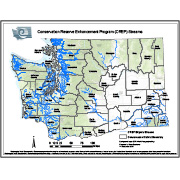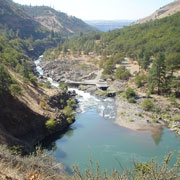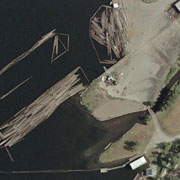Endangered Species Act (ESA) Compliance
Biological Assessment for Trinity River Hatchery
US Bureau of Reclamation with DJ Warren
& Associates
As a component of its Coho Hatchery and
Genetic Management Plan, Meridian biologists
prepared a Biological Assessment to evaluate
the effect of the Trinity River Hatchery's
non-ESA listed Chinook Salmon and steelhead
programs on Southern Oregon/Northern
California Coast Coho Salmon, Southern
Resident Killer Whale, Eulachon, and Green
Sturgeon. Input for this BA was obtained from
NOAA Fisheries, two Tribes, and the California
Department of Fish and Wildlife. The effect of
hatchery produced coho salmon on natural coho
populations was the primary focus of the
evaluation.
Statewide Programmatic Biological Assessment
Washington State Conservation Commission

Meridian prepared a programmatic Biological
Assessment to evaluate the effects of the Farm
Service Agency's Conservation Reserve
Enhancement Program (CREP) on listed plant and
animal species. The CREP program plants native
trees and shrubs to improve riparian condition
and enhance wetlands along salmon-bearing
streams throughout Washington State. The
programmatic BA covers project implementation
statewide and allows the program to bypass
permitting on a project by project basis. As
of 2017, over 1,150 projects were enrolled in
the CREP program.
Biological Assessment for the Lewis River Hydroelectric Projects
PacifiCorp
Meridian biologists analyzed potential effects
of continued operation of four major
hydropower projects on listed bull trout,
Chinook and chum salmon, steelhead, and 14
wildlife and plant species. We produced two
BAs for formal Section 7 consultation between
FERC and NMFS and USFWS that evaluated effects
on ESA listed fish population connectivity;
habitat quantity and quality within three
reservoirs and downstream river reaches; fish
propagation and enhancement measures; river
ramping and instream flows; and reintroduction
of salmon and steelhead to over 170 miles of
habitat. NMFS and USFWS issued Biological
Opinions for the continued operation of these
four projects.
Biological Assessments for Kootenai River Habitat Restoration Program
Kootenai Tribe of Idaho and BPA
Meridian prepared multiple Biological
Assessments to evaluate the effects of aquatic
habitat restoration at several sites along a
50-mile reach of the Kootenai River, Idaho,
primarily assessing impacts to listed white
sturgeon and bull trout and their critical
habitat. These efforts met ESA Section 7
requirements and the USFWS approved each of
the BAs. Meridian also prepared a programmatic
BA covering restoration project implementation
from 2013 through 2016. This approach
effectively streamlined compliance for the
annual instream construction projects.
Meridian also prepared ESA documentation for
the Tribe's terrestrial habitat/wetland
restoration program.
Biological Assessment of the Lyle Falls and Castile Falls Fish Passage Facilities
Bonneville Power Administration, with DJ
Warren & Associates 
Meridian prepared a Biological Assessment to evaluate the effects of upgrading the existing Lyle Falls and Castile Falls fishways on the Klickitat River to improve fish passage and population monitoring. Meridian evaluated project effects on listed steelhead and bull trout to meet ESA Section 7 consultation requirements. NMFS and USFWS approved the project and construction occurred in 2009.
Barbee Lumber Mill Biological Assessment in Lake Washington
Lloyd and Associates, Inc. 
Meridian designed and implemented a detailed,
SCUBA-based assessment of existing fish
habitat and fish populations within and near a
site in Lake Washington that had previously
been used as a log transfer facility for the
Barbee Lumber Mill. The proposed action
involved dredging to remove accumulated bark
debris. Meridian biologists conducted and
supervised three seasonal SCUBA-based aquatic
habitat surveys within the study area,
summarized the results of each survey in a
series of technical reports, and analyzed the
effects of the proposed action (dredging) on
aquatic habitat quality and quantity, fish
population abundance and diversity, macrophyte
density and diversity, and ESA-listed fish
species. Meridian photographed underwater
aquatic habitat conditions at the survey site,
recommended measures to minimize impacts on
all candidate, proposed and listed fish
species potentially affected by the proposed
action, and facilitated negotiations with the
state and federal resource agencies. Meridian
also prepared two 10-year programmatic
Biological Assessments addressing the effects
of the ongoing proposed action on ESA-listed
Chinook salmon and steelhead as part of a
Clean Water Act Section 404 permit
application.

